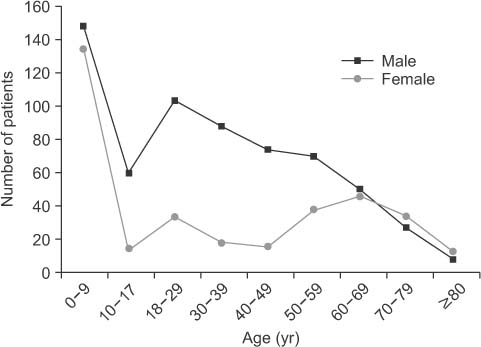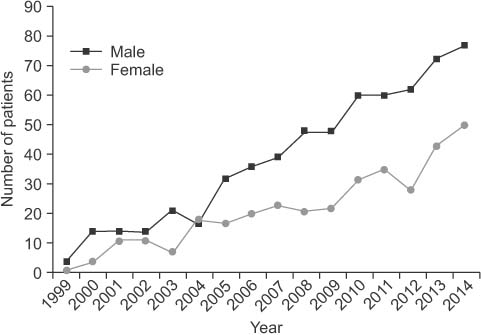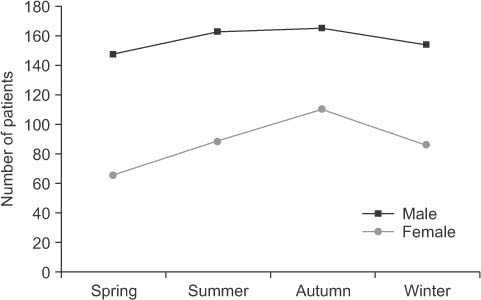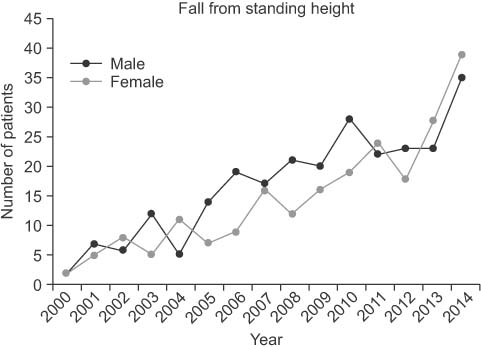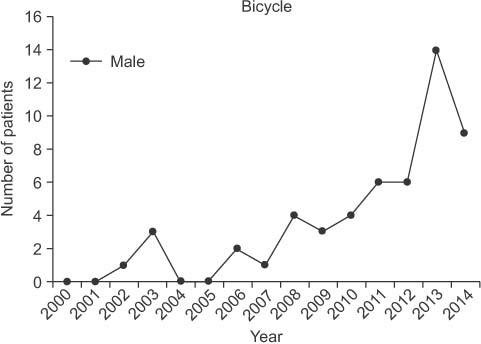J Korean Orthop Assoc.
2016 Dec;51(6):455-463. 10.4055/jkoa.2016.51.6.455.
An Epidemiological Study of Clavicle Fractures for Koreans in the Metropolitan Area
- Affiliations
-
- 1Department of Orthopedic Surgery, Seoul National University Hospital, Seoul, Korea. orthoyhl@snu.ac.kr
- KMID: 2364296
- DOI: http://doi.org/10.4055/jkoa.2016.51.6.455
Abstract
- PURPOSE
Though clavicle fractures are the second most common fractures to occur in active adults, there have been a few epidemiological studies conducted on the Korean population in recent years. To better understand clavicle fractures, an epidemiological study reflecting the changes in current life style and injury mechanism may be important. Hence, the purpose of this study was to conduct an epidemiological study on the Korean population.
MATERIALS AND METHODS
This was a retrospective study of 973 patients (977 cases) who presented with clavicle fractures from January 2000 to August 2015. Radiological results were classified by the Allman system-3 groups and 7 subgroups. The study collected information regarding gender, age at the event of injury, injury mechanism, other associated injuries, occurrence rate of each year, and seasonal variation.
RESULTS
The study consisted of 627 male patients (64.4%, 1 bilateral case) and 346 female patients (35.6%, 3 bilateral cases). The mean age at the time of injury was 31.8±24.9 years (male, 31.2±22.6 years; female, 32.7±28.7 years). Midshaft clavicle fractures (Allman group I) were the most common with 758 cases (77.6%). There were 397 cases with displacement (40.6%). The occurrence of clavicle fractures decreased with increasing age in male patients and showed a bimodal distribution in female patients. Injury due to a fall from standing height was the most common mechanism of injury. There were 61 cases (6.2%) who had other associated injuries and the most common associated injury was a rib fracture. The occurrence of clavicle fractures increased with time, and falling was associated with the highest occurrence rate of clavicle fractures.
CONCLUSION
The mean age of clavicle fracture was 31.8 years in a recent 15-year period. The occurrence of fracture in male patients was 1.8 times than female patients, primarily occurring as midshaft fractures. There were more cases of displacement than minimally displaced cases. The most common injury mechanism was a fall from standing height, and the occurrence of clavicle fractures has shown an increasing trend recently.
Keyword
MeSH Terms
Figure
Reference
-
1. Court-Brown CM, Heckman JD, McQueen MM, Ricci WM, Tornetta P III, McKee MD. Rockwood and green's fractures in adults. 8th ed. Philadelphia: Wolters Kluwer Healt;2015. p. 1427–1429.2. Nordqvist A, Petersson C. The incidence of fractures of the clavicle. Clin Orthop Relat Res. 1994; (300):127–132.
Article3. Buhr AJ, Cooke AM. Fracture patterns. Lancet. 1959; 1:531–536.
Article4. Neer CS 2nd. Nonunion of the clavicle. J Am Med Assoc. 1960; 172:1006–1011.
Article5. Pannike A. Clavicular fractures: etiology, classification, diagnosis. Hefte Unfallheilkd. 1982; 160:43–54.6. Rowe CR. An atlas of anatomy and treatment of midclavicular fractures. Clin Orthop Relat Res. 1968; 58:29–42.7. Nordqvist A, Petersson CJ. Incidence and causes of shoulder girdle injuries in an urban population. J Shoulder Elbow Surg. 1995; 4:107–112.
Article8. Postacchini F, Gumina S, De Santis P, Albo F. Epidemiology of clavicle fractures. J Shoulder Elbow Surg. 2002; 11:452–456.
Article9. Robinson CM. Fractures of the clavicle in the adult. Epidemiology and classification. J Bone Joint Surg Br. 1998; 80:476–484.10. Allman FL Jr. Fractures and ligamentous injuries of the clavicle and its articulation. J Bone Joint Surg Am. 1967; 49:774–784.
Article11. Zhu X, Li W, Chen Z. Analyses of epidemiology in 363 cases of clavicle fractures. Zhongguo Xiu Fu Chong Jian Wai Ke Za Zhi. 2004; 18:275–276.12. Nowak J, Mallmin H, Larsson S. The aetiology and epidemiology of clavicular fractures. A prospective study during a two-year period in Uppsala, Sweden. Injury. 2000; 31:353–358.13. Stanley D, Trowbridge EA, Norris SH. The mechanism of clavicular fracture. A clinical and biomechanical analysis. J Bone Joint Surg Br. 1988; 70:461–464.
Article14. Sankarankutty M, Turner BW. Fractures of the clavicle. Injury. 1975; 7:101–106.
Article
- Full Text Links
- Actions
-
Cited
- CITED
-
- Close
- Share
- Similar articles
-
- Current concepts in the treatment of midshaft clavicle fractures in adults
- Conservative Treatment of Mid-Clavicle Fractures
- Stress Fracture of the Proximal Clavicle after Parallel Bars Exercise in a Young Male
- Current Concepts for Classification and Treatment of Distal Clavicle Fractures
- Periprosthetic Clavicle Shaft Fracture After Treatment of Type V Distal Clavicle Fracture Using a Hook Plate: A Report of Two Cases


